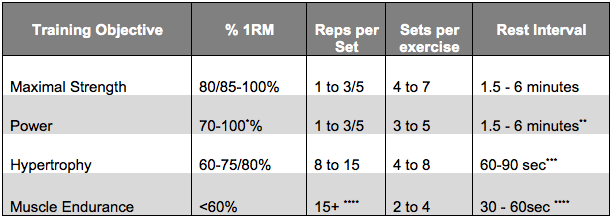
If you're searching through training articles on elitefts.com, there is probably a good chance you have a training program you follow when you walk into the weight room. Now, how each of you got that program is probably going to differ, as each and every one of you probably doesn’t share the same goals, resources, and knowledge.
Having worked on both the applied and academic side of the exercise/training field, one thing I’ve noticed over time is that people are really stuck on, “following their programs,” without really knowing or understanding each aspect of that program. At the same time, I’ve also noticed that people are often unhappy with how a program “worked” and then spend quite a bit of time jumping from one new program to the next. Personally, I think program promiscuity and dissatisfaction are often the result of not understanding the aspects of one's program, the adaptations the program is meant to impose, and how execution of that program has the ability to change the adaptations that later occur. Believe it or not, your muscles can’t read and don’t care about what percent of their one rep max is loaded on the bar. They also don’t really care about what adaptation that load or those reps is supposed to bring about. Instead, they care about the how that load and those reps affect their fatigability, force output, speed of contraction, resistance to damage, and ability to repair. Unfortunately, this concept is often lost. More often then not, people pick their programs based on what the program claims to offer rather than what is written. I’m sure many people have downloaded things that say something like, “12-weeks to increase your squat,” because the program name was best suited for their goals, and not the actual program itself.
RECENT: Are You Getting Enough O2? — Oxygen's Role in Muscle Growth
I’ve come across a lot of those people who are frustrated with their programs. When I meet those frustrated people, the first question I ask is, “What is the goal of your training?” I’m essentially asking them what adaptations they hope to acquire from those hours they spend moving iron.
These are some of the answers I commonly get:
- I want to increase how strong I am (maximal/absolute strength)
- I want to increase how powerful I am (rate of force development/ explosive strength/power)
- I want to increase how big my muscle are (hypertrophy)
- I want to increase my muscles’ abilities to continue to work at submaximal loads (muscle endurance)
Once I hear their answer, before I even look at their current training program, I then ask, “Where did you get your current program?”
These are the most common answers I get:
- Online/Google
- From a coach
- From a website /forum
- From a training book/ebook
- From a magazine
I then ask them what information the program includes.
These are the most common answers I get:
- The exercises
- The number of reps to do
- The load to use on those reps (%1RM)
- The number of sets to do
- And amount of rest to take between sets
That is important information to have, but it is also limited in its ability to help you. Understanding stimuli, adaptations, and objectives is critical when selecting a program.
Let me introduce you to a chart. This chart is one many people, trainers, and coaches use when prescribing sets, reps, and percentages needed to achieve specific training outcomes.
*Sometimes reported as between 30-70% of 1RM or 55-80% of 1RM1Note: these are all approximations. There is variability in reporting of these things in currently literature.
**Reported in Supertraining as 2-6 minutes2
***2-5 minutes of rest suggested in Supertraining2
****25-60 reps and 1-2 minute or rest suggested in Supertraining2
This type of chart is made for the “average." It’s cookie-cutter. And, that’s the problem. You see, training is all about individuality and specificity. Thus, charts aren’t bad, they’re basic, and more of a stepping stone than road map.
Since these charts are guidelines, but not the whole story, they really need to be elaborated on for people to use them, and their programs, in the way in which they were intended. For example, you could be following a program to increase your 1RM squat (maximal strength). Let’s imagine that program has you doing a lot of work in the five-rep range, between 80-85% depending on the given day.
Imagine a squat day looks something like this:
- Back Squat: 83% x 5 sets x 5 reps (main lift)
- Front Squats: 70% x 3 sets x 3 reps
- Good Mornings: 3 sets x 5 reps
- Hanging Leg Raises: 3 sets x 15 reps
There is nothing really wrong with this. But, let’s take a step back and break down how this could work well for one lifter, and not another, when it comes to increasing maximal strength. First off, whenever using a program, it’s a good rule of thumb to set your intensities at 97-99%, not 100%, of your 1RM. Why? Because rarely will you come into the gym with 100% of your strength potential accessible.
Now, look at the programmed intensity of the main lift (the back squat). That might be HARD! At 85%, five reps might be a near maximal attempt. As fatigue starts to set in, it is really going to test you. If you are a fast lifter (think dive bomb squats), each set might consist of fewer than 20 seconds of time under tension. However, if you are a slower lifter (think slow, grinded out reps), a single set might be creeping into the range of 20+ seconds. Accordingly, the type of lifter you are may influence your adaptations to this program. In fact, my guess would be that if you are a grinder, you might build some muscle mass from this type of programing, even though you are never doing compound barbell movements over the five-rep range.
Each program and type of training will elicit different, yet specific, adaptations2. At the most fundamental level, muscle contractions occur as a result of nervous processes driving voluntary muscle movements. These movements are displays of maximal force, speed, power, or fatigue resistance. As a result, the integrity and the intent of performed and prescribed exercises are critical to getting the adaptations you are after. This is significantly more important than what is written on any program sheet. Muscle plasticity and adaptability can’t read sheets. Instead, muscles just interpret the physiological and biochemical conditions that you present them with. And, if those conditions don’t match what the sheet intended, your adaptations will no longer be specific to the sheet’s intentions, but to the conditions you have created in training.
Training effects are really determined by:
- The specificity of one's training
- The training potential of an individual
- The training volume of the program (sets, reps, intensities)
- The organization of the training load (frequency, distribution, sequencing, interdependence)2.
In the example above, the squat is being trained in an “intensity” which should elicit an adaptation that supports increases in maximal, voluntary, strength. But, when the lift is occurring for upwards of 20 seconds, a couple of things start to occur. In theory, loads above 80% are aimed at targeting strength. As force output rises, the velocity of the movement drops, as does subsequent power output1. Since the “grinder” is moving with a slow velocity, and the time under tension is increasing, other adaptations could be starting to occur.
First, the 20+ second set increases the time under tension during the concentric part of the triphasic squat movement, thus increasing the energy needed to complete the reps. Increasing the energy requirement or “metabolic stress” of the set promotes hypertrophic responses via activation of myogenic pathways. Additionally, as you increase the time under tension, you subsequently increase the mechanical tension placed onto the muscle cell membranes. By doing that, anabolic pathways activate to promote muscle growth (reviewed in3). Additionally, longer time under tension often results in more mechanical trauma/muscle damage, which leads to more training induced “micro-tears”. To repair those micro-tears, muscle satellite cells proliferate, differentiate, and fuse to the injured fibers. This process gives rise to larger, thicker, fibers; also known as hypetrophy4. Thus, those sets of five reps go from being a strong maximal strength stimulus to a potent hypertrophic one.
At the end of the day, though, these charts should really come with a disclaimer that defines training stimuli and the training objectives they lead to. Defining the various components of training objectives allows lifters to adjust their training mid-session to make sure the stimulus they apply to their body is in line with their objectives. So, let's modify the chart and set up some definitions.
Maximal Strength
Goal: To have a group of muscles generate a maximal voluntary contraction (aka maximal force) against an external load.
Power
Goal: To increase how much work (aka force and velocity) you can do in a unit of time; as power = force x velocity. You are training to move as much load as possible, as fast as possible. Power can be divided into two categories:
- High Power Output: activities that are attempting to generate near maximal or maximal force as fast as possible.
Example: All out 100-meter sprint.
Energy System: ATP/CP
- Sub-Maximal Power Output: activities that consist of withstanding submaximal-power outputs over longer durations of time while moving as fast as possible.
Example: 100 power cleans for time in some CrossFit WOD.
Predominate Energy System: oxidative metabolism/aerobic .
Hypertrophy
Goal: Increasing the size/components/cross sectional area of muscles. This can also be broken down into two categories.
- Cytoplasmic Hypertrophy
Goal: Growth/expansion of non-contractile components/proteins and fluid within the extracellular spaces of muscle cells and between muscle fibres2; thus resulting in an increase in the cross sectional area.
- Contractile Hypertrophy
Goal: Growth of the contractile components within muscle cells. Increasing in the size and number (added in series or parallel) of sarcomeres that make up myofibrils (reviewed in3), thus increasing the area density of myofibrils and the ability to exert strength/force. Note: sarcomeres added in series increase a muscle’s length; added in parallel, they increase the ability of the muscle to produce tension/force.
Muscle Endurance
Goal: Increase to produce and withstand submaximal strength for prolonged periods of continual repetitions/movements without significant fatigue.
So, maybe the chart needs to be updated to look something like this:
*Sometimes reported as between 30-70% of 1RM or 55-80% of 1RM1Note: These are all approximations. There is variability in reporting of these things in currently literature.
**Reported in Supertraining as 2-6 minutes2
***2-5 minutes of rest suggested in Supertraining2
****25-60 reps and 1-2 minute or rest suggested in Supertraining2
Here is the thing: every training program is developed to help you meet a goal. Thus, not just the program, but also the way you execute each set and rep needs to be done in the way in which it was intentionally prescribed. And, once you understand what your training objectives actually are, and the different stimuli that help you accomplish those objectives, it becomes a lot easier to select the right training program for your goals and needs. So, with our updated table, go find, or make, a program that works for you.
References
1. Dietz, C. & Peterson, B. Triphasic training : a systematic approach to elite speed and explosive strength performance, (Bye Dietz Sport Enterprise, Hudson, WI, 2012).
2. Siff, M.C. & Verkhoshansky, Y.V. Supertraining : special strength training for sporting excellence : a textbook on the biomechanics and physiology of strength conditioning for all sport, (Supertraining International, Denver, 1999).
3. Schoenfeld, B.J. The mechanisms of muscle hypertrophy and their application to resistance training. Journal of strength and conditioning research / National Strength & Conditioning Association 24, 2857-2872 (2010).
4. Rosenblatt, J.D., Yong, D. & Parry, D.J. Satellite cell activity is required for hypertrophy of overloaded adult rat muscle. Muscle & nerve 17, 608-613 (1994).















4 Comments